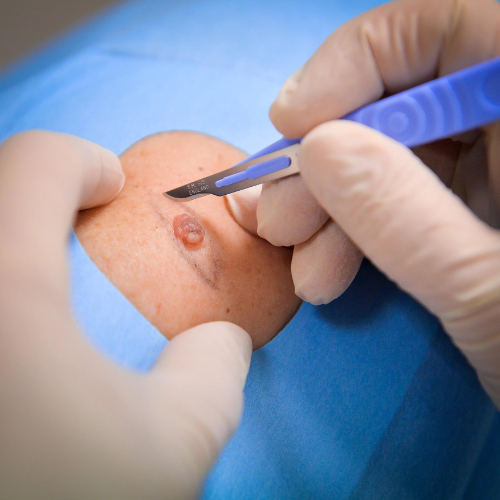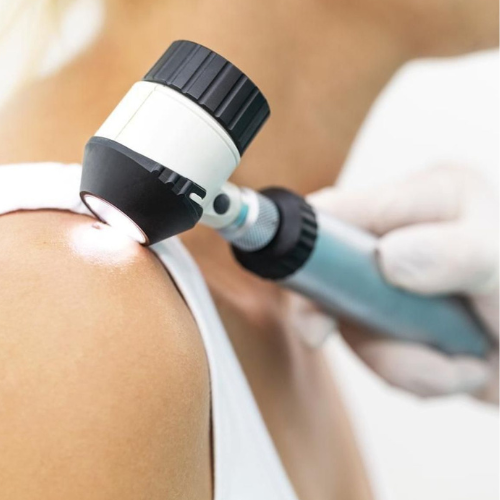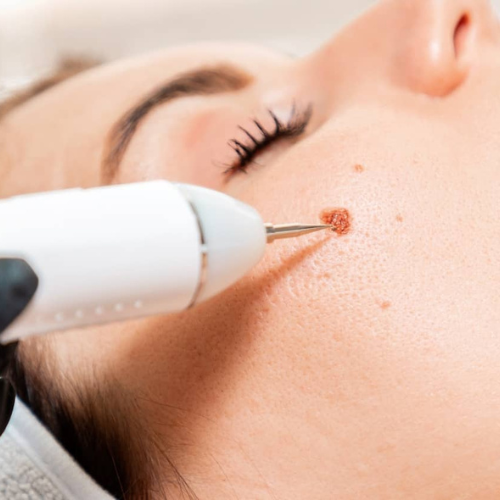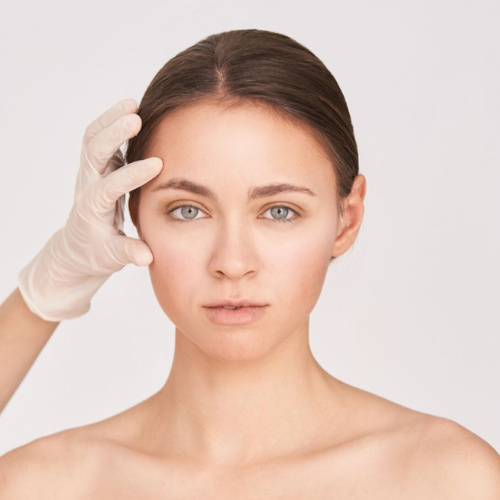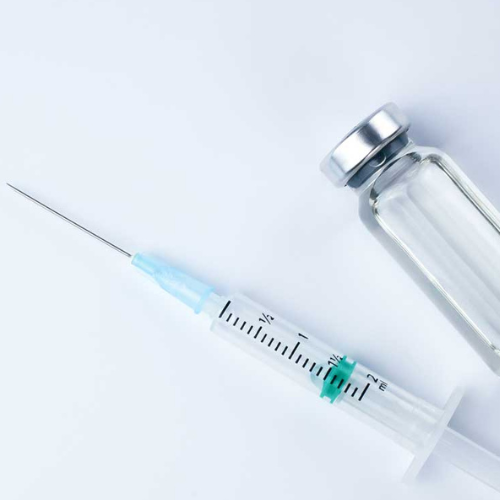Dermatology
As the body's largest organ, the skin plays an essential role in protecting us from external aggressors and regulating various physiological processes. Skin is also a reflection of our overall health, lifestyle and emotional well-being.
Taking care of our skin is therefore crucial to maintaining its health and appearance. This includes adopting a skincare routine tailored to our individual needs, protecting against damage from the sun and external elements, a balanced diet and adequate hydration, as well as stress and lifestyle management.
By investing in healthy skin care habits and consulting health professionals when necessary, we can help preserve our skin's youthfulness and radiance, while promoting our overall well-being.
Grains of beauty
Moles, also known as nevi, are small pigmented spots that form on the skin. They can be of different colors, such as brown, black or even reddish.
Moles are generally caused by an accumulation of melanocytes, the cells responsible for producing melanin, the pigment that gives skin its color. Melanocytes are distributed throughout the skin and produce melanin to protect the skin from the harmful effects of the sun's ultraviolet (UV) rays.
The main causes of moles include:
- Sun exposure: UV rays can stimulate the formation of melanocytes, leading to the formation of moles. Excessive exposure to the sun without appropriate protection can increase the risk of developing moles.
- Genetic factors: Genetic predisposition can play a role in the formation of moles. If members of your family have many moles, you may be at increased risk.
- Hormones: Hormonal changes, such as those occurring during puberty, pregnancy or the use of hormonal contraceptives, can influence mole formation.
- Age: Moles can appear at any age, but tend to form more frequently during childhood and adolescence.
It is important to note that most moles are harmless, but it is advisable to monitor any changes in their appearance. Changes such as a change in the size, shape, color or edges of a mole can be signs of concern, and it's advisable to consult a dermatologist for a thorough evaluation.
OUR SOLUTIONS FOR REMOVING A MOLE
SKIN EXCRESCENCE
Skin excrescences are abnormalities of the skin that appear as small protuberances or masses. They can vary in size, shape, color and texture. There are different types of skin growths, each with its own characteristics. Common types of skin growths include :
- Acrochordons (or cutaneous pendulomas): These are small excrescences of flesh attached to the skin by a thin stalk.
- Warts: Warts are rough growths on the skin caused by viral infection, usually with the human papillomavirus (HPV).
- Seborrheic keratoses: also known as "age spots", these are benign skin lesions that generally appear on sun-exposed areas of the skin, such as the face, neck and back of hands.
- Soft fibroids: These are small, soft, flexible skin growths, often flesh-colored, that can appear on various parts of the body.
- Epidermoid cysts: These are sacs filled with keratin, a protein naturally present in the skin, which form beneath the skin's surface.
- Lipomas: These are benign fatty masses that form under the skin. They are generally soft to the touch and mobile.
These skin growths are generally benign and do not lead to serious health problems. However, it is important to monitor any skin growth and consult a dermatologist if it shows changes in size, shape, color or texture, or if it causes symptoms such as itching, bleeding or irritation. In some cases, removal of skin growths may be recommended for aesthetic reasons or to avoid any potential complications.
OUR SOLUTIONS FOR REMOVING SKIN GROWTHS
Xanthelasma
Xanthelasma is a skin condition characterized by the appearance of small yellowish or pale yellow patches on the skin around the eyelids, particularly near the inner corner of the eye. These patches are generally flat and soft to the touch. Xanthelasma is a manifestation of cholesterol deposits under the skin and is often associated with high blood cholesterol levels or metabolic problems.
Here are some key points about xanthelasma:
- Causes: Xanthelasma is mainly caused by an accumulation of cholesterol in the skin cells around the eyelids. This can be linked to high blood cholesterol levels (hypercholesterolemia), metabolic disorders such as diabetes, obesity or hereditary factors.
- Appearance: Xanthelasma patches are usually yellow or pale yellow in color. They can vary in size and shape, from small patches to larger plaques that can cover a significant part of the eyelid.
- Symptoms: Apart from the aesthetic aspect, xanthelasma does not generally cause painful or irritating symptoms. However, it can be a cause for concern from an aesthetic point of view, particularly if it is visible and affects self-confidence.
OUR SOLUTIONS FOR TREATING XANTHELASMA
SKIN TUMORS
Cutaneous tumors are growth abnormalities that form on the skin. They can be benign (non-cancerous) or malignant (cancerous). Here are some common types of skin tumors:
- Melanoma: This is an aggressive form of skin cancer that develops from pigment cells called melanocytes. Melanoma can appear as a new spot or lesion on existing skin, and may be associated with changes in color, size, shape or texture.
- Basal cell carcinoma (BCC): This is the most common type of skin cancer. It develops from the basal cells of the epidermis and usually presents as a small, pearly bump, a reddish patch or a non-healing sore.
- Squamous cell carcinoma: This type of skin cancer forms from the squamous cells of the epidermis. It may appear as a rough bump, sore or crust on sun-exposed skin.
- Keratoacanthoma: This is a benign skin tumor that sometimes resembles squamous cell carcinoma. It develops rapidly and may resemble a red pimple or bump with a hollow center.
- Naevi (moles): Naevi are benign skin tumors that form from pigment cells in the skin. They can be flat or raised, brown, black or pinkish in color.
- Soft fibromas (acrocordons): These are small, benign skin growths that usually form on the neck, armpits, eyelids or skin folds. They are generally harmless, but can be removed for aesthetic or comfort reasons.
It's important to regularly monitor the skin for any new tumors, changes in existing tumors or abnormal signs. Suspicious skin tumors should be evaluated by a dermatologist for an accurate diagnosis and appropriate treatment plan. Early detection of malignant skin tumors can be crucial for effective treatment and positive outcomes.
OUR SOLUTIONS FOR TREATING SKIN TUMORS
Scar or Surgical Sequela
A surgical scar or aftereffect refers to a mark or change in the skin that remains after surgery. Scars can vary in appearance, size and texture depending on factors such as the surgical technique used, the healing capacity of each individual's skin and post-operative care.
Here are some common types of scars or surgery after-effects:
- Normal surgical scar: After surgery, a normal scar usually forms at the incision site. It may be thin, flat and close in color to the surrounding skin. Over time, the scar may fade and become less visible.
- Hypertrophic scarring: Hypertrophic scarring occurs when the scar is thicker, firmer and more visible than normal. It may be red or pink and may persist for months or even years after surgery. Hypertrophic scars can sometimes cause itching or discomfort.
- Keloid scars: Keloid scars are similar to hypertrophic scars, but are distinguished by their excessive growth and extension beyond the boundaries of the original incision area. They may be thick, raised and dark in color. Keloid scars can be more difficult to treat than hypertrophic scars.
- Adhesions or fibrosis: After certain surgical procedures, adhesions or fibrosis may form. These are scar tissues that connect internal structures and can sometimes cause restricted movement or pain.
- Aesthetic sequelae: In addition to visible scars, some surgical procedures can leave aesthetic sequelae such as asymmetries, slight deformities, changes in skin texture or color.
